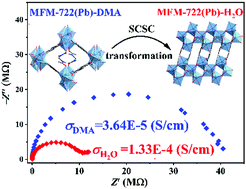Enhanced proton conductivity in a flexible metal–organic framework promoted by single-crystal-to-single-crystal transformation†
Abstract
MFM-722(Pb)-DMA undergoes a single-crystal-to-single-crystal (SCSC) transformation to give MFM-722(Pb)-H2O via ligand substitution upon exposure to water vapour. In situ single crystal impedance spectroscopy reveals an increase in proton conductivity due to this structural transition, with MFM-722(Pb)-H2O showing a proton conductivity of 6.61 × 10−4 S cm−1 at 50 °C and 98% RH. The low activation energy (Ea = 0.21 eV) indicates that the proton conduction follows a Grotthuss mechanism.

- This article is part of the themed collection: Functional Coordination Networks


 Please wait while we load your content...
Please wait while we load your content...